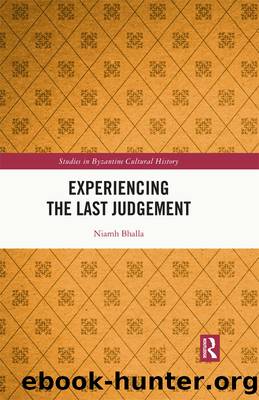Experiencing the Last Judgement by Niamh Bhalla;

Author:Niamh Bhalla;
Language: eng
Format: epub
Publisher: Taylor & Francis (Unlimited)
Published: 2021-06-25T00:00:00+00:00
140Velkovska 2001: 37. 141 The twelfth-century Typikon of Athanasios Philanthropenos for the Monastery of St Mamas in Constantinople, for example, describes the preparation of the monk's body for burial complete with monastic habit. See BMFD: 1020. 142 For instance, the saved come before Christ as groups of martyrs, confessors, the chaste, monks and virgins; and the damned include murderers, robbers, adulterers and idolaters, etc. See Life of Basil the Younger, V. 143 On commemorating the dead in Byzantium, see Brooks 2005; Kotoula 2007. Ann Marie Yasin has also demonstrated the relationship between commemorative contexts and the construction of Christian identity in her exploration of Late Antique church sites, primarily in North Africa. Yasin 2009: 56â100. 144 See Brooks 2005: 103. On funerary monuments not only commemorating departed individuals, but reinforcing community identity, see Yasin 2005. 145Underwood 1966â75: I, pls. 537â9; III, 276â8; Ousterhout 1995a: fig. 12; Brooks 2005: 46; Karahan 2010: 332. 146 On gender and memory, see Lourie, Stanton & Vicinus 1987: 1â7; Hirsch & Smith 2002: 6; Chedgzoy 2007. On social amnesia, see Burke 1989: 106; Irwin-Zarecka 1994: 115â29; Schudson 1995: 328; Bal 1999: 75. Women came last, however, emphasising the hierarchy of wider society as a whole, although perhaps Ioane is to be commended for including two choirs of female saints at the bottom of the hierarchy rather than the usual one choir, found on the twelfth-century Sinai icon for example (Figure 1.2). However, he also includes a disproportionate number of nuns in the lake of fire with at least seven identifiable through their headdress, whilst only two obviously male monastics are included, with a further monk prominently begging Christ for mercy at the front of the choir of the damned (Figure 5.6). The image thus contributed to the ânaturalisation of a significant difference on the axis of sexâ, whereby even those women who were martyred for the faith are behind monks who had denied themselves through asceticism alone.150 The social order was shared in this world and the next and on this icon from Sinai it becomes clear that this hierarchy was created in response to its context.
The labelling of the groups within the image of the Last Judgement created representative categories in order to construct and rank social orders. In this context it is no surprise that, after the prophets, bishops in the form of the Church Fathers were singled out as foremost in the hierarchy of the saved, although they are further down the hierarchy on the twelfth-century Sinai icon. On both, they are the first led into paradise as is often the case in these images, although they are behind Ioane on the hexaptych icon. One bishop is included in the lake of fire on Ioane's icon and none on the twelfth-century icon. By the early eighth century, the monastery had become an archbishopric after the abolition of that of Pharan, with the archbishop also serving as the abbot of Sinai.151 It is thus understandable that their presence is primarily in the heavenly realms on the two Sinai icons.
Download
This site does not store any files on its server. We only index and link to content provided by other sites. Please contact the content providers to delete copyright contents if any and email us, we'll remove relevant links or contents immediately.
Phoenicians among Others: Why Migrants Mattered in the Ancient Mediterranean by Denise Demetriou(564)
Verus Israel: Study of the Relations Between Christians and Jews in the Roman Empire, AD 135-425 by Marcel Simon(561)
Caesar Rules: The Emperor in the Changing Roman World (c. 50 BC â AD 565) by Olivier Hekster(541)
Europe, Strategy and Armed Forces by Sven Biscop Jo Coelmont(486)
Banned in the U.S.A. : A Reference Guide to Book Censorship in Schools and Public Libraries by Herbert N. Foerstel(457)
Give Me Liberty, Seventh Edition by Foner Eric & DuVal Kathleen & McGirr Lisa(456)
Reading Colonial Japan by Mason Michele;Lee Helen;(447)
The Roman World 44 BC-AD 180 by Martin Goodman(443)
american english file 1 student book 3rd edition by Unknown(442)
DS001-THE MAN OF BRONZE by J.R.A(432)
The Dangerous Life and Ideas of Diogenes the Cynic by Jean-Manuel Roubineau(423)
Introducing Christian Ethics by Samuel Wells and Ben Quash with Rebekah Eklund(419)
The Oxford History of World War II by Richard Overy(418)
Imperial Rome AD 193 - 284 by Ando Clifford(416)
Basic japanese A grammar and workbook by Unknown(415)
Literary Mathematics by Michael Gavin;(379)
Language Hacking Mandarin by Benny Lewis & Dr. Licheng Gu(356)
How to Reach the 9.0 in IELTS Academic Reading by IELTS Medical(340)
The Oxford History of the Renaissance by Campbell Gordon;(337)
